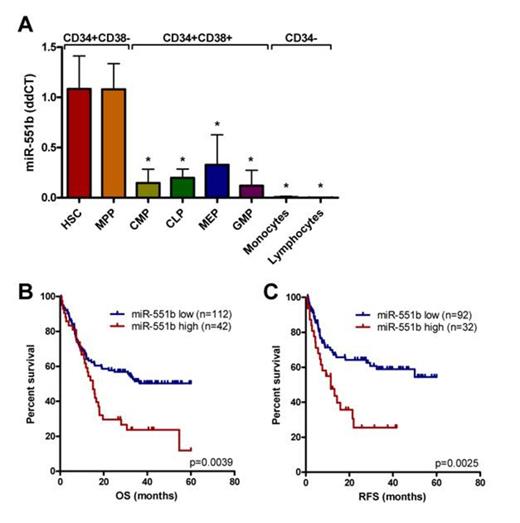Abstract
Over the last past years microRNAs (miRNAs) have emerged as important regulators of normal hematopoiesis. Growing evidence suggests that miRNAs that are expressed and function in hematopoietic stem cells (HSC) are especially important in the pathogenesis of acute myeloid leukemia (AML). HSC characteristics like self renewal, quiescence and the ability to overcome senescence have shown to be under control of miRNAs and contribute to the aggressiveness of AML. Recently we identified microRNA-551b (miR-551b) as a miRNA that is highly expressed in residual normal HSC in AML bone marrow. Thus far, no functional or clinical relevance has been described for miR-551b. To explore its clinical impact we here investigate the expression of miR-551b in highly enriched stem and progenitor cell populations in normal bone marrow and in a cohort of AML patients.
Normal bone marrow showed highest expression of miR-551b in the two most primitive CD34+CD38- populations i.e. CD90+CD45RA- HSC and CD90-CD45RA- multipotent progenitor cells. In the more differentiated progenitor and mature cell populations, miR-551b expression was strongly reduced suggesting its involvement in early hematopoiesis (Figure A). To investigate whether miR-551b is expressed and of prognostic importance in AML we performed qRT-PCR expression analysis in well defined de novo AML bone marrow samples (n=154). High miR-551b expression was associated with lower complete remission (CR) rates after first-line standard-dose remission-induction therapy (p=.015) and shorter relapse free survival (RFS; p=.003) and overall survival (OS; p<.005) (Figure B/C). Also in cytogenetically normal AML high expression was associated with poor outcome (OS p=.02 and RFS p=.009). Combining miR-551b expression at diagnosis with minimal residual disease (MRD) detection after the second cycle of chemotherapy improved the prognostic value of MRD detection. Patients who were positive for MRD and/or highly expressed miR-551b showed shorter OS (p=.01) and RFS (p=.001) compared to patients who were both MRD negative and had low miR-551b expression. Moreover, in the group of MRD negative patients a higher chance of relapse was found if patients expressed miR-551b highly compared to those with low expression (66.7 vs. 27.6%). In multivariate analysis, high miR-551b expression remained an independent predictor for overall survival (p=.049) and relapse free survival (p=.001). In line with miR-551b being an early hematopoietic miRNA, high expression was correlated with more undifferentiated morphology. To shed more light on the biological role of miR-551b we correlated its expression to mRNA sequencing data in a large publically available dataset [Ley et al., NEJM 2013]. Many of the genes that highly correlated with miR-551b like: MLLT3, INPP4B, HTR1F, HOPX, PROM1 and others, are also present in published HSC gene signatures. Gene ontology analysis of the correlated genes showed significant enrichment for genes involved in hematopoiesis and cell adhesion.
Our results show that miR-551b is a HSC specific miRNA and that high expression in AML is associated with a poor prognosis possibly because it reflects a stem cell-like state. Currently our research focuses on the functional role of miR-551b in normal and malignant hematopoiesis.

No relevant conflicts of interest to declare.
Author notes
Asterisk with author names denotes non-ASH members.

This feature is available to Subscribers Only
Sign In or Create an Account Close Modal